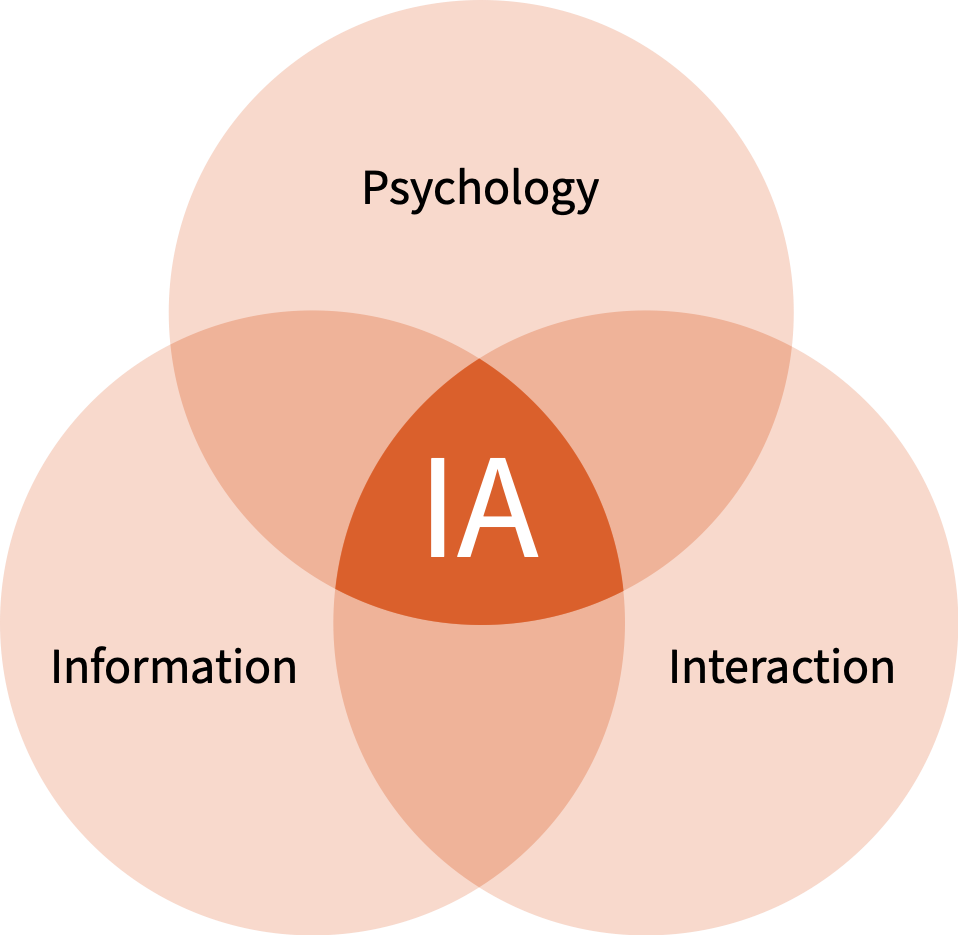Occasionally, I feel compelled to justify the discipline of information architecture. Most recently, it was due to the release of Duly Noted. A few reviews have included a variant of the phrase, “the author [i.e., me], an ‘information architect,’ says that…” Note the quotation marks. The reviewer likely thinks, “I’ve never seen the phrase ‘information architect’ before, so this author must have made it up.”
Of course, I didn’t. IA has been around for decades. Alas, the discipline hasn’t achieved mainstream acceptance. Which is a pity: Information architecture is needed now more than ever.
Information environments are where we work, shop, bank, learn, play, and communicate. Human experience mediated through information structures: that’s the object of design after software ate the world. People need information systems that meet them on their own terms, using language they understand. That’s why information architecture matters.
So, IA needs to be more widespread. But how? Can any designer do it? Yes, but it requires mastering a particular set of skills. I group them into three broad areas:

Let’s look at them more closely.
Human Psychology
As I mentioned above, the object of design is human experience. The key outcomes of a design project are successful human interactions, such as finding and filling out the correct form, quickly locating the right product in a vast online store, and meeting a suitable mate.
Designers working on such systems must understand basic psychology: what motivates and repels people. But it doesn’t stop there. They must also understand how people think about the system domain — i.e., their mental models.
For example, I assume you and I have a similar mental model of “design” in the context of this essay. I expect you understand we’re focused on software-mediated experiences. But after my last post, a reader emailed me to complain about the state of physical design, including automobiles, industrial products, and packaging. I don’t write about these things, but I can’t assume readers know that. “Design” is a broad umbrella. My bad!
You can’t understand mental models by reading books. You must do research with real people. That said, Don Norman’s The Design of Everyday Things is a book I’d recommend to someone getting started with psychology in design.
Information Structures
Understanding people is only one half of the equation. Understanding how information is structured is the other half. I don’t mean this in the abstract: you must grok how things like databases and metadata work. You must also understand “information primitives”: basic ways to organize information so it can be useful and understandable. They include:
- Name-value pairs
- Taxonomies
- Nodes and links
- Matrices
Information can be organized relationally, hierarchically, or in ad-hoc networks. The ways of doing this aren’t infinite. It behooves you to understand which ways work best for which purposes. One way to gain this knowledge is by implementing a project that requires it — e.g., an online store or other information repository that requires tagging data with multiple facets.
First-hand knowledge will help you understand the possibilities and constraints of different information structures. Building architects must understand the structural capabilities of steel, wood, and brick. You must do the same with information. Don’t just read about it, do it. Get a feel for how metadata works, how databases store data, and how taxonomies are managed. (That said, books can help: check out Heather Hedden’s The Accidental Taxonomist for the latter.)
Points of Interaction
The last area of focus is where design comes in. Design is a way of addressing challenges by abduction – that is, by making things and seeing how well (or not) they rise to the challenge. To oversimplify, design works by
- honing in on a particular challenge,
- producing a hypothesis for addressing the challenge,
- testing the hypothesis under real-world conditions,
- revising the hypothesis based on test results, and
- doing it again and again.
The key is that you can’t test hypotheses in the abstract: you must put a prototype in front of real people. What you learn from these interactions will lead you to refine the prototype. You repeat the cycle as long as it takes to either produce a good fit or abandon the hypothesis. Alas, information architecture operates primarily in the abstract; its main deliverables are boxes-and-arrows diagrams that represent information primitives.
Many people find it hard to envision a house when they see floor plans, and they also find it hard to imagine an app or website when they see a site map. But helping envision outcomes isn’t the only reason to make prototypes. An untested IA is a gamble: it may make sense to you, but you have more sophisticated mental models about the system than your users. You can’t validate other people’s understanding by showing them diagrams; you must build things they can interact with.
But even that’s not the only reason to make “real” things. As with information structures, first-hand knowledge of UI will give you a sense of what can/can’t be done practically.Again, architects must understand the characteristics of steel and wood if the are to know which are best suited for particular purposes. You must do the same for the ways people interact with information structures.
I don’t have a reading recommendation here; this really requires that you roll up your sleeves and get a feel for UI. It’s especially important now when there’s so much variety and change in interaction paradigms. (E.g., how do you prototype a spatial experience in Vision Pro? I bet 2-D wireframes won’t cut it.)
Do It for Real
Effective information architecture requires that designers embrace a multifaceted approach: they must understand human psychology, information structures, and how people interact with information systems. It’s not enough to understand these things in theory. You must get out and do the research, build and manage databases, and prototype new user experiences.
And what’s more, all three keep shifting. Although psychology is remarkably stable, the means for understanding it are evolving. (Consider the degree to which remote interviews have changed research.) And, of course, how we organize and interact with information (i.e., back-end and front-end) are evolving very fast.
Mastering three areas may feel like a big ask. But it gets harder. I’ve left out other skills that are table stakes: systems thinking, effective communication, analytical skills, active listening, and project management. All of these are essential, but more broadly so. (They’re not specific to IA; you can’t succeed in organizational settings without them.)
Yes, it’s a lot. That may be why IA isn’t yet a more mainstream discipline. But it’s only by developing these core skills that you can design systems that address people on their terms while providing more capable products and services. Given the increasing pervasiveness of information-mediated experiences, it’s an essential discipline for the future.
